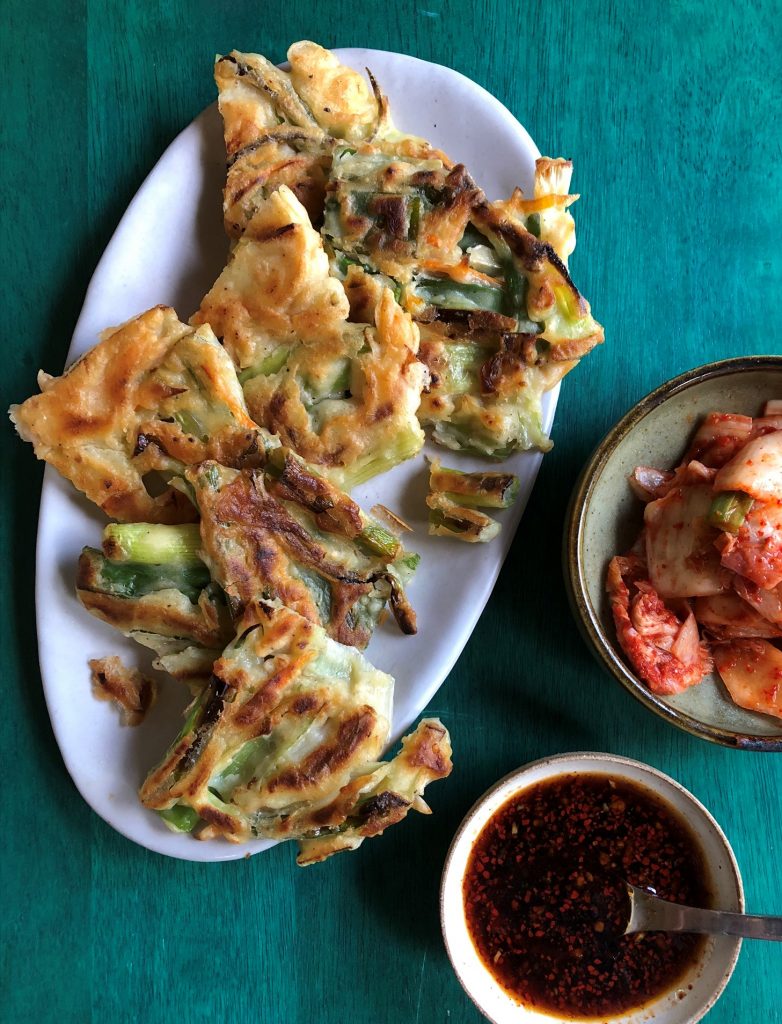
Chef-authored cookbooks often give me pause. They can be too technical and fussy with minutia because the recipes aim to replicate what's made at the chef's restaurant. They may seem rushed and sloppy with a lack of details. Sometimes, the book displays a deficit of thoughtfulness (making 4 cups of salad dressing doesn't work for most home cooks).
Korean cooking is super popular nowadays and Hooni Kim's new book, My Korea, delivers recipes that are chef-fy but loaded with wiggle room and details to help home cooks learn and riff. Kim is a talented New York-based chef and restaurateur who serves up well crafted, balanced food. I'd been to his Manhattan establishments and have been looking forward to his debut cookbook. His editor told me that My Korea had some delays, but I was happy to wait. She sent me the book this spring, and I've been reading it for weeks, dreaming up Korean meals.
The chapter that caught my attention was the Anju (drinking snacks) one. It contained some of my Korean favorites — like pajeon pancakes, which I've had a tough time mastering. They seem easy enough to make at home, but I've not been able to dial in the delicate crispness of my ideal. Kim's recipe, from his headnote to his detailed instructions generously offers insights to generate crispy, delicate results. His honest, accessible tone runs throughout the book.
Anjus are not served with rice. They're noshing foods, Kim explains. That's fine because it liberated me to enjoy the pajeon with drinks in the early evening, a light soup for a fun lunch, and a salad and dumplings for a light meal. I've eaten lots of pajeon since My Korea arrived at my doorstep.
Get Saucy First
The first thing you want to make is Kim's pajeon sauce. It keeps up to two weeks in the fridge. I made a half batch for the pancakes. Next time, I'll double it because then I can make pajeon twice within the span of fourteen days!
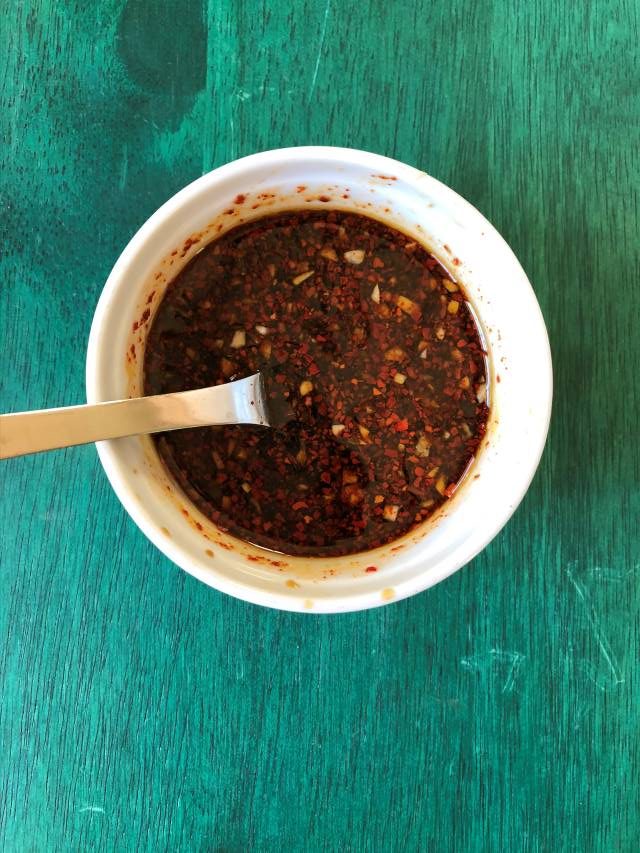
The other thing with the sauce is requires gochugaru, mild to moderately-hot Korean chile flakes. McCormick spices sells the pepper in small jars, but it's used im large quantities in kimchi, sauces, and countless other Korean foods. That explains the one-pound bag commonly found at Korean and some Chinese markets. If you don't want to head to an Asian market, shop online. If available, substitute a similar kind of pepper, such as Maras (Marash) or Aleppo pepper for the Korean pepper.
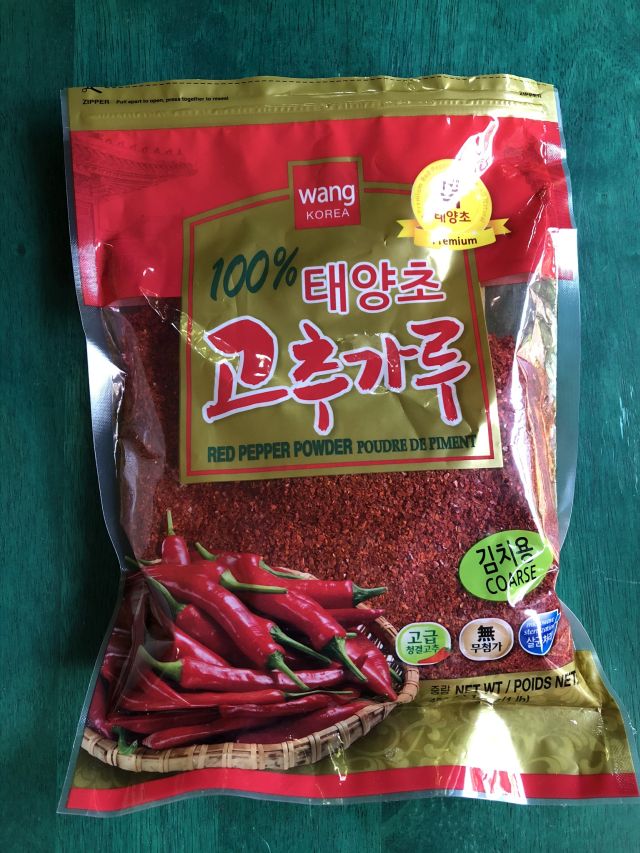
Flour Options
You'd think that Asian pancakes use rice flour but they don't. Like Chinese scallion pancakes (see below for recipes at VWK), Korean pajeon uses wheat flour. In test driving Kim's recipe, I used both regular all-purpose and a gluten-free flour blend that contains rice.
With something like pancakes that's leavened with baking powder, substituting a gluten-free flour blend like Bob's Red Mill's isn't likely to destroy things. In the video below, you'll see the results.
Add-ins Options
Green onions (scallion) play the dominant role in these pancakes but I added carrot and shrimp to some that I've made using the recipe in My Korea. I figured this out: Use a low-moisture ingredient to avoid weighing things down. With the green onion, I patted them dry and let them air dry for adding them to the batter.
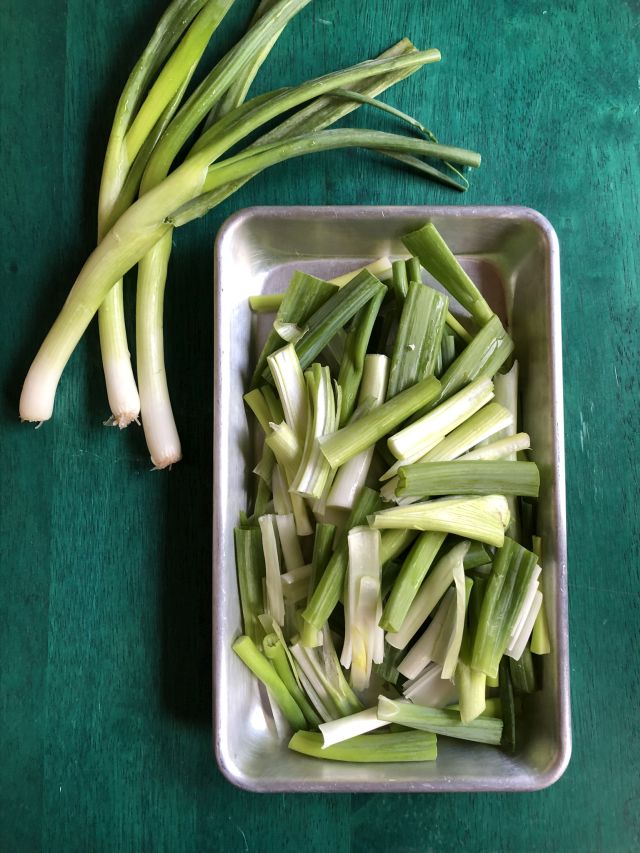
Kim suggested adding greens like chrysanthemum, which I lacked since the peppery vegetable are an Asian market find. There was a lot of kale in my garden so I picked some and chopped them up into one-inch wide ribbons about 2 inches long. They cooked up wonderfully to produce a crisp, light finish. You could use arugula, if you like. Definitely keep moisture in mind for your add-ins. With the carrot that I used in the video, it's not much; a handful or two will do. Green onion remained the star.
If you want to add chopped shrimp, use about 6 ounces of peeled and deveined medium or large ones. Via Instagram, Kim said ramps would be great this time of the year but he's got a pajeon soft spot for shrimp and squid pancakes. The point is this -- you have choices to play with this Korean recipe!
How to Make Korean Scallion Pancakes Video
I've been tinkering with video production and here's my latest. You'll see, uh, a mistake and troubleshooting in the process.
Storing and Reheating Korean Scallion Pancakes
We're a household of two. I suggested gifting the neighbors leftovers but my husband wanted to keep the extra pancakes. While pajeon are best very soon after they're out of the skillet, they're all right reheated. Store leftovers in the fridge and return them to room temperature.
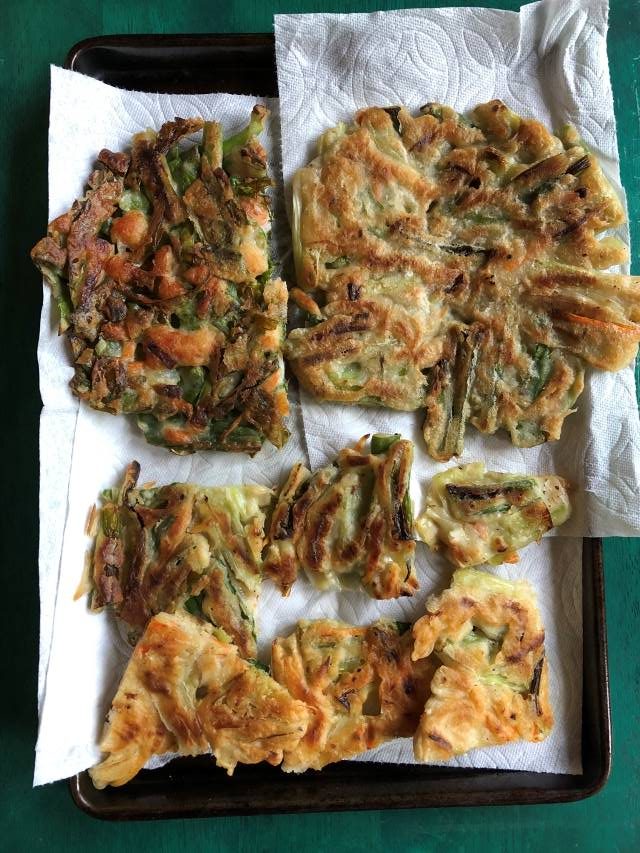
To reheat, set the pancakes (or quartered pancakes) on a rack set inside a rimmed baking sheet. Bake them in the upper third level of a preheated 400F oven for 8 to 12 minutes, flipping midway when you see and/or hear gentle sizzling. If you have a convection roast function, use it to circulate heat better. In an air-fryer, use 350F and about 5 minutes, flipping midway. Regardless, let the pajeon cool a minute before diving in.
The pancakes soften a bit after frying so you can refry them briefly to recrisp or you use the oven method to reheat a couple at a time.
With the success of this recipe, I'll be cooking other recipes from My Korea to glean extra insights.
Kim wrote the pajeon recipe so you may tinker with it. I wholeheartedly concur so share your tips with a comment!
More Scallion-y Recipes!
- Chinese Scallion Pancakes
- Bacon and Scallion Pancakes
- Chinese-Islamic Sesame Scallion Bread
- Crispy Scallion and Tofu Rice Cakes
- Vietnamese Scallion Oil Garnish (Mo Hanh)
Scallion Pancakes (Pajeon)
Ingredients
Dipping Sauce
- 1 tablespoon water
- 1 tablespoon unseasoned rice vinegar
- 3 tablespoons soy sauce
- 1 ½ teaspoons gochugaru (Korean red chili flakes), or similar kind of mild chile flakes
- 1 garlic clove minced
- ⅛ teaspoon minced ginger
- ½ teaspoon toasted sesame oil
Batter
- 2 cups (285g) all-purpose flour, regular or a gluten-free blend such as Bob's Red Mill 1:1
- ½ cup (64g) cornstarch
- 2 teaspoons baking powder
- 2 teaspoons sugar
- ½ teaspoon recently ground black pepper
- 2 cups ice-cold club soda
- 1 teaspoon doenjang (Korean fermented soybean paste), dark Japanese miso, or Chinese bean sauce
- 1 medium egg yolk, or 2 teaspoons beaten egg yolk (see Note for another idea)
- 2 teaspoons minced garlic
Other
- 3 medium or 2 large bunches green onion, cut into 2-inch lengths (cut any thick white sections in half lengthwise before cutting crosswise)
- About ⅓ cup neutral oil such as canola or grapeseed
Instructions
- To make the sauce, combine the water, vinegar, soy sauce, chile flakes, garlic, ginger, and sesame oil. Taste and add extra water by the ½ teaspoon, if the flavor is too strong. Use right away or refrigerated up to 2 weeks in the fridge. Return to room temperature and shake or stir up before serving.
- For the batter, in a medium bowl whisk together the flour, cornstarch, baking powder, sugar, baking powder, and pepper. Make a well in the center, add the club soda, bean paste, egg yolk, and garlic, then mix gently with a whisk. Do not whisk too much, or extra gluten will form in the batter, making it too thick and doughy. Whisk about 10 times, then let the batter rest for 10 minutes in the freezer so any remaining small clumps of flour can dissolve and blend into the mixture by themselves.
- When you’re ready to make the pancakes, line a sheet pan with paper towels and set aside. Fold the scallions into the cold batter. Set a 10-inch nonstick skillet over high heat and add about 1 tablespoon of the oil. When the oil begins to shimmer and just barely smoke, add 1 cup of the scallion batter to the center of the pan. Using a spatula, spread it out to form a 7-inch pancake. (You don’t want the pancake to touch the sides of the pan, or the edges may burn before the center is cooked through.)
- Reduce the heat to medium and cook for 4 to 5 minutes, until the bottom of the pancake has set. Once set, gently slide your spatula under the edge of the pancake and lift them, tilting the pan, so some of the hot oil runs underneath the pancake. Let cook for 2 to 3 minutes more, until the bottom is deep golden brown and crisp. You can check the color by gently lifting an edge of the pancake with your spatula. Now flip the pancake and cook on the other side for 3 to 4 minutes, until it is golden brown on the second side and cooked through. Transfer to the prepared sheet pan to drain. Wipe out the pan, set it back over high heat, add another tablespoon or so of oil, and repeat until all the pancakes are cooked. You should have 4 or 5 pancakes total. The finished pancakes can be kept on a clean sheet pan while you cook the remaining ones, but it’s best to eat them right away. (See the main post for reheating tips.)
- Cut each pancake into quarters and serve with small bowls of the sauce.













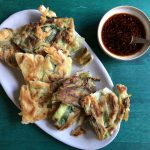


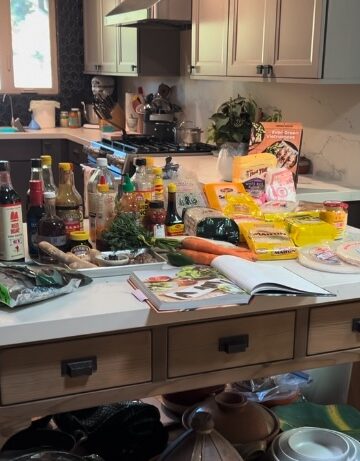
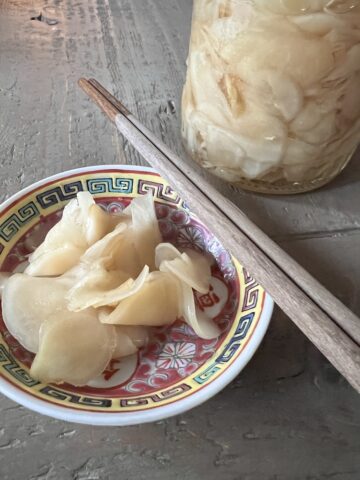
Sue R says
These look great! I must make them especially since I have spring onions almost ready to pick.
I've been waiting 45 days for your book to arrive so I know what's it's like right now. It is coming from England to Australia though.
Andrea Nguyen says
You have homegrown spring onions? Wow! They will be wonderful in this recipe!
Book delivery has been delayed because of the virus. Thank you so much for being patient. All the best to you.
ann says
Andrea, you can grow your very own spring onions at home. Just save the bottom 4 inches of spring onion that you buy from the store. I plant them directly into the soil and in a few days, you will see new stalks coming out .
Sue R says
Yes. This is what I did for the first time and they are growing like crazy. Highly recommend it. Mine are in a pot. Make sure you leave a little of the green part, they'll grow better.
Andrea Nguyen says
Of course. You need ones that are super fresh with roots, right?
ann says
Oh yes definitely. You will love it!
Frank Ball says
Andrea, I dont see the video launch button. Can you point the way?
Andrea Nguyen says
Frank, I see it in the middle of the screen. Just scroll on down to the section that says video. Click in the rectangle. People have been watching this video so I wonder why you can't see it?
Vivian Pei says
These look great, Andrea but am I missing something? Can't seem to find the video link 😉
Andrea Nguyen says
Vivian -- I see it in the page. You're the second person to mention this so I checked both Chrome and Explorer on my desktop, on my Chromebook, and iPhone. How weird. If you scroll on down to the section that says video, there should be a video player visible. Click anywhere in the rectangle. If you don't see it, try refreshing the page. Thanks for the heads up.
Vivian says
Ah it worked in Microsoft Edge and on my iPhone but not Chrome, weird. I got to see it in any case!
Andrea Nguyen says
Yay! Who knows? Technology helps and sometimes hinders.
ml says
hi andrea, initially, there was no link to the video for me either. But here's the fix-- to your other readers, you have to disable adblock on this page (temporarily), and then the video link will pop up both in the main body and on the side.
Andrea Nguyen says
Ah, of course. The adblock. Advertisement keeps this site afloat so I appreciate people unblocking it while at VWK. Thanks for the insight!
Oanh says
Andrea - I have also struggled with pa jeon texture so very excited to see this recipe! How would you suggest adapting for a Kim chi pa jeon, given your notes on trying to not weigh the batter down (i.e., with damp veggies or too many carrots)? I’m also curious how much you think the ice cold club soda makes a difference in this recipe, since the batter needs to sit for at least 10 minutes anyway.